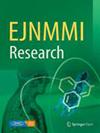Quantitation of mitral regurgitation using positron emission tomography
IF 3.1
3区 医学
Q1 RADIOLOGY, NUCLEAR MEDICINE & MEDICAL IMAGING
引用次数: 0
Abstract
Cardiac positron emission tomography (PET) offers non-invasive assessment of perfusion and left ventricular (LV) function from a single dynamic scan. However, no prior assessment of mitral regurgitation severity by PET has been presented. Application of indicator dilution techniques and gated image analyses to PET data enables calculation of forward stroke volume and total LV stroke volume. We aimed to evaluate a combination of these methods for measurement of regurgitant volume (RegVol) and fraction (RegF) using dynamic 15O-water and 11C-acetate PET in comparison to cardiovascular magnetic resonance (CMR). Twenty-one patients with severe primary mitral valve regurgitation underwent same-day dynamic PET examinations (15O-water and 11C-acetate) and CMR. PET data were reconstructed into dynamic series with short time frames during the first pass, gated 15O-water blood pool images, and gated 11C-acetate myocardial uptake images. PET-based RegVol and RegF correlated strongly with CMR (RegVol: 15O-water r = 0.94, 11C-acetate r = 0.91 and RegF: 15O-water r = 0.88, 11C-acetate r = 0.84, p < 0.001). A systematic underestimation (bias) was found for PET (RegVol: 15O-water − 11 ± 13 mL, p = 0.002, 11C-acetate − 28 ± 16 mL, p < 0.001 and RegF: 15O-water − 4 ± 6%, p = 0.01, 11C-acetate − 10 ± 7%, p < 0.001). PET measurements in patients were compared to healthy volunteers (n = 18). Mean RegVol and RegF was significantly lower in healthy volunteers compared to patients for both tracers. The accuracy of diagnosing moderately elevated regurgitant volume (> 30mL) was 95% for 15O-water and 92% for 11C-acetate. LV regurgitation severity quantified using cardiac PET correlated with CMR and showed high accuracy for discriminating patients from healthy volunteers.利用正电子发射断层扫描对二尖瓣反流进行定量分析
心脏正电子发射断层扫描(PET)可通过一次动态扫描对灌注和左心室(LV)功能进行无创评估。然而,目前还没有通过 PET 评估二尖瓣反流严重程度的先例。对 PET 数据应用指标稀释技术和门控图像分析可以计算前向搏量和左心室总搏量。与心血管磁共振(CMR)相比,我们的目的是评估结合这些方法使用动态 15O 水和 11C 醋酸 PET 测量反流容积(RegVol)和反流分数(RegF)的效果。21 名患有严重原发性二尖瓣反流的患者接受了当天的动态 PET(15O-水和 11C-乙酸酯)和 CMR 检查。正电子发射计算机断层显像数据被重建为动态序列,其中包括第一次扫描的短时间帧、门控 15O 水血池图像和门控 11C 醋酸心肌摄取图像。基于 PET 的 RegVol 和 RegF 与 CMR 密切相关(RegVol:15O-水 r = 0.94,11C-醋酸 r = 0.91;RegF:15O-水 r = 0.88,11C-醋酸 r = 0.84,p 30mL),15O-水为 95%,11C-醋酸为 92%。使用心脏 PET 定量的左心室反流严重程度与 CMR 相关,在区分患者和健康志愿者方面显示出很高的准确性。
本文章由计算机程序翻译,如有差异,请以英文原文为准。
求助全文
约1分钟内获得全文
求助全文
来源期刊

EJNMMI Research
RADIOLOGY, NUCLEAR MEDICINE & MEDICAL IMAGING&nb-
CiteScore
5.90
自引率
3.10%
发文量
72
审稿时长
13 weeks
期刊介绍:
EJNMMI Research publishes new basic, translational and clinical research in the field of nuclear medicine and molecular imaging. Regular features include original research articles, rapid communication of preliminary data on innovative research, interesting case reports, editorials, and letters to the editor. Educational articles on basic sciences, fundamental aspects and controversy related to pre-clinical and clinical research or ethical aspects of research are also welcome. Timely reviews provide updates on current applications, issues in imaging research and translational aspects of nuclear medicine and molecular imaging technologies.
The main emphasis is placed on the development of targeted imaging with radiopharmaceuticals within the broader context of molecular probes to enhance understanding and characterisation of the complex biological processes underlying disease and to develop, test and guide new treatment modalities, including radionuclide therapy.
 求助内容:
求助内容: 应助结果提醒方式:
应助结果提醒方式:


